
| Bad Astronomy |
|
|
|
BA Blog
|
|
Q & BA
|
|
Bulletin Board
|
| Media |
|
|
|
Bitesize Astronomy
|
|
Bad Astro Store
|
|
Mad Science
|
|
Fun Stuff
|
| Site Info |
|
|
|
Links
|
| RELATED SITES |
| - Universe Today |
| - APOD |
| - The Nine Planets |
| - Mystery Investigators |
| - Slacker Astronomy |
| - Skepticality |
Buy My Stuff

Keep Bad Astronomy close to your heart, and help make me
filthy rich. Hey, it's either this or one of those really
irritating PayPal donation buttons here.
Phil's Los Angeles Adventure
One of the best perqs of my job is that I get to travel to fun places. Well, not everyplace I go is fun, and it isn't always such a perq, but sometimes things work out better than I hope. This happened when I went to Los Angeles in March of 2003.
I was invited to give a public talk at the California State University at Northridge (CSUN), which is a sister school to my own Sonoma State University. The talk would be part of their "Distinguished Lecture" series (clearly, they didn't know me very well). Since CSUN is in LA, I figured I would try to see if I could get some other gig in the area.
I called my friend Tami. She works at Dryden Flight Research Center, a NASA center north of LA in the desert. She does a lot of educational work there, putting on teacher workshops, developing activities for students, and anything else that can help people understand what NASA does in aerospace research.
Tami and I bump into each other at educational conferences, and the last time we met she gave me a standing invitation to come down to Dryden to give a talk. When I called her, I collected on that offer, and she agreed.
Then I had an interesting thought. Years ago, I met a man named Andre Bormanis, who is a writer for Star Trek, and now works on the show "Enterprise". We have exchanged emails over the years, talking about astronomy and Trek. He also gave me a standing invitation to visit the set next time I was in LA. I called him, and he said sure, come on down. I couldn't believe it! After some manipulating of schedules, I was able to get all three visits organized; Dryden on Wednesday, March 12, Trek the next day, and CSUN on Friday. I couldn't believe my luck!
Dryden Flight Research Center
The visit to Dryden was extremely cool. I stayed with Tami and her husband Ed the night before, and they also had over an old friend named Kerr. We had to get up at 4:45 a.m., since it's an hour and a half drive to Dryden from her house. The drive is mostly through desert, which was eerie and beautiful.
When we got there, Tami immediately went to work. She planned a teacher workshop around my visit, and she had her hands full. 55 teachers had signed up, an unusually high number. The day would consist of an intro to Dryden and the educational facilities there that the teachers could use, a tour of the grounds, my Moon Hoax talk, and a workshop where they would learn about more activities (including one my group at SSU developed).
Since we got up so early, my first mission was to acquire some coffee. Tami showed us where the kitchenette was, but there was hardly any coffee left. An older gentleman came up, and I told him the coffee was out, and I didn't feel comfortable rooting around looking for supplies. He laughed and set about making more coffee. I thanked him and went on my way. I didn't think anything of the encounter, but later Tami clued me in that the man was none other than legendary test pilot Bill Dana! He flew on the X-15 as well as countless other military planes and rocket planes. That was the first of many extremely cool things I was about to experience.
 After coffee, Ed, Kerr, and I were treated to a "behind-the-scenes"
tour of Dryden. Our first stop was a tour inside the 747 that is used
to ferry the Space Shuttle back to Florida if it has to make a landing
in California due to bad weather on the east coast. It looks like an ordinary
747, except for some struts on the top that hold the Shuttle. That was
an interesting sight, both inside and outside. It was sobering, knowing
that Columbia had ridden the jet, but it was also pretty neat
to sit at the controls of a piece of history.
After coffee, Ed, Kerr, and I were treated to a "behind-the-scenes"
tour of Dryden. Our first stop was a tour inside the 747 that is used
to ferry the Space Shuttle back to Florida if it has to make a landing
in California due to bad weather on the east coast. It looks like an ordinary
747, except for some struts on the top that hold the Shuttle. That was
an interesting sight, both inside and outside. It was sobering, knowing
that Columbia had ridden the jet, but it was also pretty neat
to sit at the controls of a piece of history.
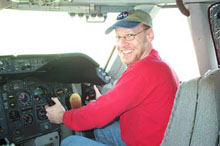
We then went to the building where pilots train to use the ejection seats in their planes. A great guy named Bob McElwain showed us the facility. He took us into a back room which had some explosives in it (to power the ejection seats) and we had to touch a copper strip to get rid of any static electricity in our bodies. That was a bit sobering. We also took a look at some mock-ups of ejection seats, while Bob regaled us with stories of his encounters training pilots over the years, including Chuck Yeager, the first man to break the sound barrier.
The next stop was the coolest of the day: the F-18 jet hangar. Inside the hangar were several of the planes that NASA uses for atmospheric research. My first impression was how beautiful they were, and sleek. Then I realized they were a lot bigger than I was expecting. Kerr remarked that the hangar looked like a car showroom. He turned to me and asked "Do you have any in blue?"
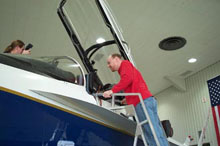 Incredibly, they let each of us in turn sit in the cockpit of one of
the planes. Ed went first, then me. It was a tight fit, and I can imagine
that with the canopy down, it's pretty close in there. Ed McElwain showed
us how the ejection seat works, and I was extremely careful to
keep my hands well away from the rope loop which activates the mechanism.
I remembered that my friend Dan Durda has flown several times in one of
these F-18s, perhaps even the very one in which I was sitting. Over the
years Dan and I have talked of collaborating on one project or another,
but I think I'll leave the Top Gun stuff to him. Sitting in one of those
overmuscled machines brought home what a wuss I am. I don't even like
roller coasters, and turbulence in a commercial planes makes my palms
sweaty. I like my F-18s to be safely on the ground, in a hangar, and preferably
without any fuel in them, just in case. You can't be too careful.
Incredibly, they let each of us in turn sit in the cockpit of one of
the planes. Ed went first, then me. It was a tight fit, and I can imagine
that with the canopy down, it's pretty close in there. Ed McElwain showed
us how the ejection seat works, and I was extremely careful to
keep my hands well away from the rope loop which activates the mechanism.
I remembered that my friend Dan Durda has flown several times in one of
these F-18s, perhaps even the very one in which I was sitting. Over the
years Dan and I have talked of collaborating on one project or another,
but I think I'll leave the Top Gun stuff to him. Sitting in one of those
overmuscled machines brought home what a wuss I am. I don't even like
roller coasters, and turbulence in a commercial planes makes my palms
sweaty. I like my F-18s to be safely on the ground, in a hangar, and preferably
without any fuel in them, just in case. You can't be too careful.
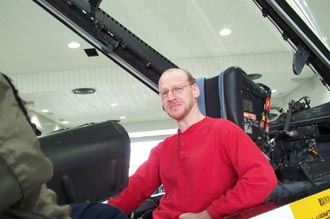
Ed asked Bob McElwain how old the planes were, and surprisingly, some of them are twenty years old or more. McElwain told us that one used to be flown by the Blue Angels! When he told us that, I turned to Kerr and said, "Hey! I guess they really do have one in blue."
After the F-18s, we went to a flight simulator to see what it was like to fly a jet. The setup was incredible; while the graphics may be somewhat primitive, the controls were amazingly responsive and realistic, thanks to a Silicon Graphics Onyx 10000 computer grinding away to run the simulation. The jets are fantastically powerful; I was "cruising" at six or seven thousand feet, then hit the throttle and pulled back on the stick; in a few seconds I was at 20,000 feet. Had I been in a real jet, I probably would have blacked out from the acceleration. I pulled a few stunts, including a high-speed barrel roll, flipping the plane over along its long axis, watching the ground spin around me. I thought about pulling an upside-down 4g negative dive, but then realized that if I got caught in the jet wash I might go into a flat spin. I'd have to eject, and Goose would be killed. I refrained.
We all tried landing the plane; Kerr ditched short of the runway but was able to walk away. I got on the runway, but landed too hard, probably damaging the plane.Ed, that jerk, landed on the runway like he had done it a hundred times before. I now have a lot more respect for jet pilots, like I didn't have enough before.
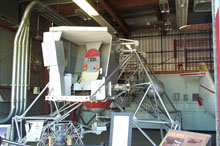 After the private VIP tour, we joined the teachers for a normal, average,
peon tour of the facility. We saw quite a bit, including the Lunar
Landing Research Vehicle, or LLRV, which
was the testbed for the Apollo astronauts to simulate the lunar landings.
It was huge, and very strange-looking. It was hard to believe it would
fly, but it had been used many times by the astronauts. In fact, over
200 landings were tested and successfully run during the Apollo training.
The Moon hoax twinkies claim that there was never a successful landing
with the LLRV, despite the clear public record of the machine. But then,
logic and truth aren't major factors of Hoax claims. There is famous footage
of Neil Armstrong ejecting from the LLRV, which of course the twinkies
love to talk about, but somehow they never mention the good landings.
After the private VIP tour, we joined the teachers for a normal, average,
peon tour of the facility. We saw quite a bit, including the Lunar
Landing Research Vehicle, or LLRV, which
was the testbed for the Apollo astronauts to simulate the lunar landings.
It was huge, and very strange-looking. It was hard to believe it would
fly, but it had been used many times by the astronauts. In fact, over
200 landings were tested and successfully run during the Apollo training.
The Moon hoax twinkies claim that there was never a successful landing
with the LLRV, despite the clear public record of the machine. But then,
logic and truth aren't major factors of Hoax claims. There is famous footage
of Neil Armstrong ejecting from the LLRV, which of course the twinkies
love to talk about, but somehow they never mention the good landings.
Incidentally, as we stood looking at the LLRV, a B2 with a tag plane flew by about four or five miles away. They were little more than dots, but it was amazing to see it. Actually, we saw a lot of jets flying in formation all day long, and when we were inside buildings we could still hear the roar of their engines. If I worked at Dryden I'm not sure I'd ever get any work done; I'd always be running outside to watch the show.
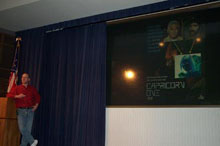 After lunch I had the extreme honor of giving my "Moon Hoax"
talk as part of a center-wide colloquium. Several of the Dryden bigwigs
were there, and I got a pretty good response. They also gave me a box
set of videos about the history of Dryden research into flight, which
I am eager to watch!
After lunch I had the extreme honor of giving my "Moon Hoax"
talk as part of a center-wide colloquium. Several of the Dryden bigwigs
were there, and I got a pretty good response. They also gave me a box
set of videos about the history of Dryden research into flight, which
I am eager to watch!
All in all, it was a great day, and I thank Tami Simmons and the rest of the education team at Dryden for inviting me, and showing me such an amazing facility. One lasting effect of being there will be a strengthening of my resolve to fight garbage like the Moon landing deniers. The abilities, dedication, and sheer drive of the people who work there make it clear where the truth sits, and it ain't with the hoax believers.
Enterprise
The next day was the one I was looking forward to for literally two years. My trip to Paramount Studios!
[Note: the images here (except for the one of the Paramount gate) were found on the web. Many are probably copies of copies originally from the official Star Trek website; I was not allowed to take pictures while on the sets.]

I arrived at Paramount to yet more security. They had a mirror on a pole to check under my car, and made me open the car trunk. Finding no phasers, photon torpedoes, or smuggled latinum, they let me in. I met Andre at his office. His shelves were crammed with books about Trek and astronomy (including mine!); he holds a Masters degree in astronomy and is quite knowledgable in science.
We had lunch together, which was very pleasant. Several Trek writers were at the restaurant, and "Enterprise" co-Executive Producer Brannon Braga even showed up for a moment to make sure he knew where his writers were.
Then we began the tour of the sets. I switched into Major Trek Geek Mode, poking and prowling around all the sets. Let me make this clear: the Enterprise sets are amazing. I have heard from several people that the sets for the original (Kirk and Spock) series were pretty low-budget, and up close looked cheesy. Things have certainly changed: the Enterprise sets were extremely well done, looking like nothing so much as the deck of a ship. It wasn't hard to imagine I was actually on starship. And for those of you who want to follow along, the official Star Trek website has a very slick Flash tour of the Enterprise you can take.
 We toured the "back" sets, including sickbay (did you know
there is a roll of ordinary paper towels hanging on a wall, so Dr. Phlox
can clean his hands?), the Captain's quarters (I saw the drawings of the
different "Enterprises" on the wall, beautifully done), various
passageways (cramped and long, to enable "walk and talk" scenes),
the weapons deck (I saw the torpedoes!), a transporter booth, two turbolifts,
and the engineering deck which holds the warp core.
We toured the "back" sets, including sickbay (did you know
there is a roll of ordinary paper towels hanging on a wall, so Dr. Phlox
can clean his hands?), the Captain's quarters (I saw the drawings of the
different "Enterprises" on the wall, beautifully done), various
passageways (cramped and long, to enable "walk and talk" scenes),
the weapons deck (I saw the torpedoes!), a transporter booth, two turbolifts,
and the engineering deck which holds the warp core.
 The core was initially
"undressed", meaning the set was not ready for filming, so some
of it was covered with plastic tarps. We came back later and saw it fully
dressed and lit, and it was awesome. The warp core was active, so we saw
the colored lights moving around (but don't ask: I won't reveal how that's
done).
The core was initially
"undressed", meaning the set was not ready for filming, so some
of it was covered with plastic tarps. We came back later and saw it fully
dressed and lit, and it was awesome. The warp core was active, so we saw
the colored lights moving around (but don't ask: I won't reveal how that's
done).
I also got a close-up look at the shuttle pods, which are pretty much as cramped on the inside as they look on TV. The detailing on the inside of the pods-- and indeed all over the ship-- is amazing. There are warning stickers, labels with Treknobabble on them (the gobbledygook tech-speak they use on the show), and flat-panel plasma displays covered with engineering diagrams. I remarked to Andre that clearly, the sets were made with a lot of care, even love. He agreed.
 Andre saved the Bridge for last. It's magnificent. The railings,
seats, consoles, everything, were incredibly detailed. The pilot has a
joystick/steering column which I was able to grab on to. It moved smoothly
and it felt like something that really could control a starship. The
panels were all active, showing diagrams of the ship, directional vectors,
the works. If it weren't for the facts that there was no engine noise
and that the front of the bridge was removed (the viewscreen wall section
had been moved about twenty feet away in the studio), it would have felt
real.
Andre saved the Bridge for last. It's magnificent. The railings,
seats, consoles, everything, were incredibly detailed. The pilot has a
joystick/steering column which I was able to grab on to. It moved smoothly
and it felt like something that really could control a starship. The
panels were all active, showing diagrams of the ship, directional vectors,
the works. If it weren't for the facts that there was no engine noise
and that the front of the bridge was removed (the viewscreen wall section
had been moved about twenty feet away in the studio), it would have felt
real.
 And then Andre invited me to sit in The Captain's Chair! Woohoo! That
was a TrekGeek's dream. Unfortunately, pictures are not allowed. I wish
I could, but I cannot share the experience I had with images here. It's
disappointing, but rules are rules. I guess the Trek Powers That Be don't
want the illusion spoiled or diluted by having pictures on the web of
the sets that are not lit correctly, or part of the show. I
am sad, but I understand their desires.
And then Andre invited me to sit in The Captain's Chair! Woohoo! That
was a TrekGeek's dream. Unfortunately, pictures are not allowed. I wish
I could, but I cannot share the experience I had with images here. It's
disappointing, but rules are rules. I guess the Trek Powers That Be don't
want the illusion spoiled or diluted by having pictures on the web of
the sets that are not lit correctly, or part of the show. I
am sad, but I understand their desires.
After the bridge, we went across to another set which was being prepared for shooting. It was a bar on Earth, and no, I won't tell you what the episode is about (but here's a hint). Again, the attention to detail was amazing. Pictures on the wall, the bottles, everything was done to the smallest bit. One bottle was labeled with the brand name "Pulsar"; I was tempted to steal it since my boss studies pulsars. Intelligently, I decided not to. Anyway, the bar was utterly convincing; there was even the name of the bar etched glass in the door.
We wandered off the set for a moment, checking out sets that had been used in other episodes, including a cave with "dilithium crystals" in it (actually, gypsum) and saw some interesting set pieces with Vulcan and Klingon writing on them. As we drifted back to the bar set, the crew started coming in: the bar scene was about to be shot!
 The place flooded with extras, both in civilian clothes and Starfleet
uniforms. We watched as the film crew blocked out the scene, which means
that they did a dry-run without the principal actors. It was right after
that that Andre introduced me to the episode's director:
LeVar Burton!
For those of you unfortunate souls who are not Major Trek Geeks, LeVar
played Geordi LaForge in "Star Trek: The Next Generation", and
has directed several episodes from other series. The parents out there
may know him as the host of "Reading Rainbow". He was too busy
to talk, but it was pretty cool just to meet him and shake his hand.
The place flooded with extras, both in civilian clothes and Starfleet
uniforms. We watched as the film crew blocked out the scene, which means
that they did a dry-run without the principal actors. It was right after
that that Andre introduced me to the episode's director:
LeVar Burton!
For those of you unfortunate souls who are not Major Trek Geeks, LeVar
played Geordi LaForge in "Star Trek: The Next Generation", and
has directed several episodes from other series. The parents out there
may know him as the host of "Reading Rainbow". He was too busy
to talk, but it was pretty cool just to meet him and shake his hand.
Then one of the episode's principal actors came in:
Keith Carradine,
who has a guest role as another Starfleet captain. We had just started
to chat when
Scott Bakula -- Captain Archer himself-- came in as well.
 My first impression was that he was a lot taller than I expected, easily
6 feet tall. He saw Andre, and immediately joked with him (he's known
as quite a cut-up on the set, a reputation that is well-deserved from
the few minutes I was able to watch him). He then grabbed my hand and
pumped it, while Andre introduced me. He seemed very friendly and very
outgoing, and I wish I could have spent a few minutes talking with him,
but the show must go on!
My first impression was that he was a lot taller than I expected, easily
6 feet tall. He saw Andre, and immediately joked with him (he's known
as quite a cut-up on the set, a reputation that is well-deserved from
the few minutes I was able to watch him). He then grabbed my hand and
pumped it, while Andre introduced me. He seemed very friendly and very
outgoing, and I wish I could have spent a few minutes talking with him,
but the show must go on!
The scene started shooting, but immediately there was a problem. LeVar shouted "Playback!" which gets pre-recorded sounds going, but the sound guy said that they couldn't get it working. Scott Bakula immediately made a joke about it and made like he was going to storm off the set. Everyone was in good spirits despite the problem, and I was pleased to see cameraderie and the sense of ease.
And there were more troubles to come. A waitress with a small role dropped a glass during one shot, and during a toast a moment later, I had to stifle laughing out loud when an actor's beer bottle overflowed, sending suds all over his arm and on the floor. It occurred to me that shooting a scene around food is dangerous unless lots of spare uniforms are handy.
Between takes I met Marvin Rush, who is the Director of Photography. Turns out he's an amateur astronomer, and we got to have a little shop talk. It was surreal, chatting about telescopes in a bar that wouldn't be built for 150 years!
After that, though, it was time to leave the set. Outside, Andre introduced me to Mike Okuda, who does a lot of the graphics for the show that are displayed on the panels. I was wearing my NASA hat (as I always do; remember, Major Geek) and he commented that they had a NASA emblem on a bowl in the Captain's quarters. I'll have to keep an eye out for it when I watch the show.
 There was still one last surprise. As we walked past the bridge set,
we saw
Connor Trinneer,
who plays Trip Tucker, the ship's
engineer. He was getting
made up for a photo shoot for a science
fiction magazine called "SFx".
I had literally seconds before commented on what a good actor he is, and
Andre embarrassed me by repeating it for him. Given that he was getting
makeup airbrushed on him, and was about to be herded around for the shoot,
he appeared to be in a good mood.
There was still one last surprise. As we walked past the bridge set,
we saw
Connor Trinneer,
who plays Trip Tucker, the ship's
engineer. He was getting
made up for a photo shoot for a science
fiction magazine called "SFx".
I had literally seconds before commented on what a good actor he is, and
Andre embarrassed me by repeating it for him. Given that he was getting
makeup airbrushed on him, and was about to be herded around for the shoot,
he appeared to be in a good mood.
After that it was time to go. Unfortunately, I didn't get to meet any other actors, but I can't complain. What a tour! I would like to publicly thank my friend Andre Bormanis for generously giving me so much of his time when he had scripts to revise as well. It was an amazing way to spend an afternoon. Like it has been for a lot of other astronomers, Star Trek has been a big influence on my life. Now when I watch "Enterprise", as silly as it may sound, I feel a little more connected to it. I really enjoy the show, and hope "Enterprise" has a long and exciting mission.
|
|
|
|